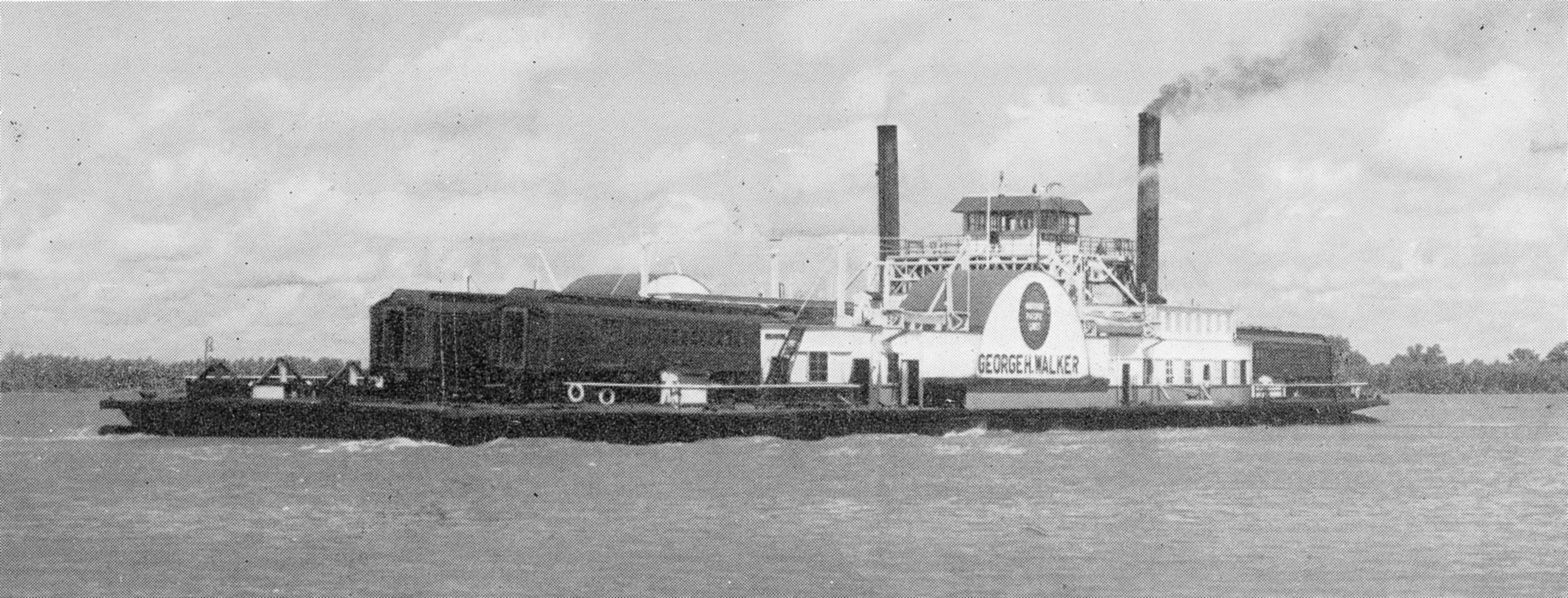There have been steamboats and towboats named for presidents of the United States. Toward the end of the steam and paddlewheel era, there was a Mississippi River train ferry named, not for a president, but for a man who had two future presidents named after him.
George Herbert Walker was an investor, businessman, and banker, a native of St. Louis and a graduate of Washington University Law School. His grandson, the late George Herbert Walker Bush, became the 41st president of the United States. Walker’s great-grandson, George Walker Bush (or “Dubya”), became the 43rd president.
Walker founded a prominent Wall Street investment firm, but in the 1920s he was also chairman of the board of the Gulf Coast Lines, a railroad running from New Orleans through Baton Rouge and Houston and on to Brownsville, Texas. This was a few years before a bridge was built at Baton Rouge, so trains had to be ferried across the Lower Mississippi River the old-fashioned way, on transfer boats or barges.
At the crossing from Baton Rouge to Anchorage, La., the Gulf Coast Lines had been using the Williard V. King, a two-track transfer boat with a capacity of 16 freight cars or eight passenger cars. In May 1922, the railroad contracted with the Dravo company of Pittsburgh to design and build a replacement, a steel-hulled boat large enough to carry entire passenger trains. Dravo came up with a design for a 340-foot sidewheeler with three train tracks. The price tag was $250,000, the equivalent of about $3.5 million today.
By late 1923, Dravo’s Neville yard had launched the George H. Walker. It was at the time the largest steel hull on the Mississippi River and tributaries. The finished boat had a length overall of 346 feet and a hull depth of 11 feet. The beam was 56 feet, but with the sponsons and paddlewheels the boat’s width was about 91 feet over the guards. The hull was divided into 26 air-tight and two oil-tight compartments. Longitudinal members in the frame were designed to transmit the jar of loading to transverse members, to minimize stress on the hull.
Inside the riveted steel hull were four 72- by 18-inch Bronson-type boilers, two on each side. The boilers were adapted for oil, but could be fired by coal if necessary.
At that time, the railroad was still using coal on locomotives between New Orleans and Baton Rouge, but otherwise preferred oil. The boat’s oil tanks had a combined storage capacity of 42,000 gallons. The boilers were designed for 200 pounds of pressure. Two boilers alone were sufficient to power the engines.
As steamboats go, the Walker was not going to win any beauty contests. It was basically a big flat deck with an unadorned, short, squat block-shaped deckhouse on each side, paddlewheel housings looming a little higher, and a simple structural bridge straddling the three tracks to hold the pilothouse above it all.
The paddlewheels were 30 feet, 6 inches in diameter, and 10 feet wide. Each wheel was independently operated, driven by its own two-cylinder, simple, noncondensing horizontal steam engine with 17- by 36-inch cylinders. Each engine developed about 600 hp. when supplied with 200 psi. of steam. The four boilers were piped together so that, combined, they could produce a total of 1,702 hp.
Maiden Voyage
The George H. Walker made its maiden voyage from Pittsburgh down the Ohio and Lower Mississippi, bypassing Baton Rouge and delivering a paying cargo of 2,000 pounds of steel products to New Orleans. After that, it was right back up to Baton Rouge for the first day of operations on October 21, 1923. The chairman of the board and other company officials were there to celebrate the occasion, but then the big transfer boat got right to work, beginning a seven-day-a-week schedule that would go on for decades.
The Walker’s daily workload included four passenger trains and a varying number of freight trains. The first passenger train was the New Orleans-bound Houstonian at 4:00 a.m. The westbound and eastbound Orleanean crossed around noontime and mid-afternoon. The last passenger trip of the day finished up at half past midnight, when the westbound Houstonian pulled ashore at Anchorage and steamed away to Houston. Add freight trains to that, and the Walker ended up averaging about 20 round trips per day.
The boat’s three tracks could accommodate one of the railroad’s largest steam locomotives plus 11 Pullman cars, or twelve 80-foot passenger cars, or 21 average freight cars.
The crossing was in the vicinity of Mile 231 AHP. The east bank landing was near the Louisiana state capitol building, and the west bank landing was just a bit farther upriver at Anchorage, making for an angled crossing distance of about a mile and a quarter.
Among the controls in the wheelhouse was a steamship-style mechanical telegraph to send commands to the enginerooms, instead of the classic bells and gongs.
Pilots on the George H. Walker over the years included Captains W.R. McArn, W.P. Aucoin, and O.D. Stalions. Capt. Stalions started on the Walker in 1932 and became master in 1937.
Crew members over the years bragged about the Walker’s continuous service, running daily in spite of storms, floods, ice floes, and whatever else the river might throw at it. The only exception was in 1939 when the boat was sent down to New Orleans for repairs.
New Bridge
Around that time, change was literally looming on the horizon for the mighty transfer boat. A railroad-and-highway bridge was built just three miles upriver at mile 233.9 AHP. Officially named the Huey P. Long-O.K. Allen Bridge (not to be confused with the Huey P. Long Bridge near New Orleans), locals in Baton Rouge today call it the old bridge, and river mariners call it the Upper Baton Rouge Bridge.
The bridge opened for business in 1940, but the George H. Walker’s railroad, by that time part of the Missouri Pacific Railroad, did not use the bridge at first. The Louisiana & Arkansas Railway (now part of the Kansas City Southern system) had a contract with the state to use the bridge, but a number of things had to happen before the Missouri Pacific would use it. Major track work for approaches and sidings had to be done, especially on the east bank, but also there had to be regulatory approval from the Interstate Commerce Commission and a contract with the State of Louisiana to share costs with the other railroad.
The pieces of this puzzle didn’t come together for several years. A contract was signed with the state in 1945, the ICC gave its approval in 1946, track work was done, and finally plans were made to start using the bridge on September 2, 1947.
An elaborate ceremony was planned for the occasion. Glenna Jenkins, the newly-crowned Miss Baton Rouge, was to preside at a flag-lowering to mark the decommissioning of the boat at the Anchorage landing. Then, Louisiana Gov. Jimmie Davis himself would pilot the first Missouri Pacific train over the bridge to the east bank.
Unfortunately, there was one last delay. Union members working for the Illinois Central Railroad, which was to handle trains on the bridge and at the sidings on the east bank, refused to work the Missouri Pacific trains until there was compensation for fellow members working for the Missouri Pacific, including crew members on the George H. Walker, who were losing their jobs.
This dispute lasted several weeks. Finally, on October 2, 1947, a Missouri Pacific train headed for the bridge. There was no beauty queen, and no singing governor on board the locomotive, but the train made it across nonetheless. Using the bridge shaved 40 minutes off the travel times for passenger trains, and much more than that off of freight train crossings.
After about a quarter century and almost half a million miles of service, the venerable George H. Walker was put out to pasture. The Missouri Pacific tried to sell it, but in the new era of big bridges and diesel power there wasn’t much market for a paddlewheel railroad transfer steamer.
The railroad ended up chopping off the pilothouse, paddlewheels, sponsons and engines, turning the great steamboat into a mere barge. It ended up at the transfer crossing from Natchez, Miss., to Vidalia, La., near Mile 363 AHP, carrying train cars as before. It was propelled, oddly enough, by an even older steamboat, the sternwheeler James Y. Lockwood, built in 1896.
Caption for photo: The steam ferry George Herbert Walker operated on the Lower Mississippi River between Baton Rouge and Anchorage, La.



